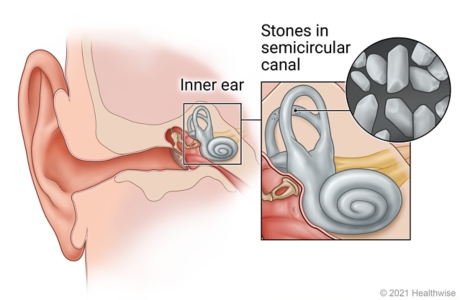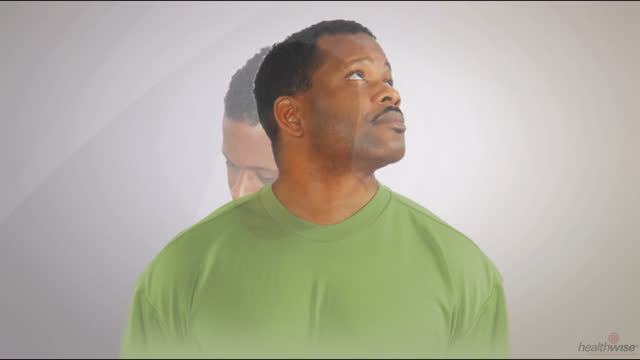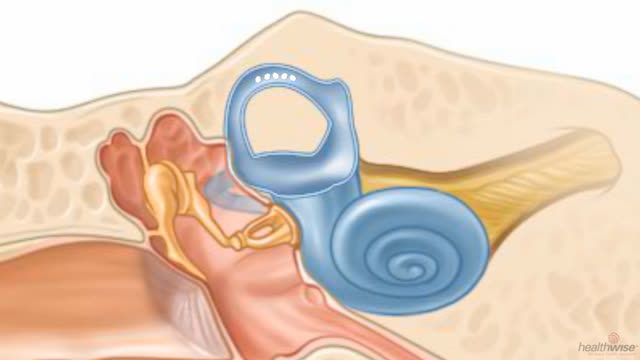Benign Paroxysmal Positional Vertigo (BPPV)
Condition Basics
What is benign paroxysmal positional vertigo (BPPV)?
Vertigo is the feeling that you are spinning or the world is spinning around you. Benign paroxysmal positional vertigo is a balance problem that causes brief vertigo spells that come and go.
For many people, BPPV goes away by itself in a few weeks, but treatment can help. It can come back again.
BPPV isn't a sign of a serious health problem.
What causes it?
BPPV is caused by a problem in the inner ear. Tiny calcium "stones" inside your inner ear help you keep your balance. When you have BPPV, these stones move into the semicircular canal in your inner ear where they can cause a feeling of spinning.
What are the symptoms?
The main symptom of BPPV is a feeling that you are spinning or tilting when you are not. It can happen when you move your head in a certain way, like rolling over in bed. You may find it hard to walk or stand without losing your balance.
How is it diagnosed?
BPPV is diagnosed with a physical exam. Your doctor will ask questions about your symptoms and past health. You may have a Dix-Hallpike test. In this test, your doctor watches your eyes while turning your head and helping you lie back.
How is BPPV treated?
BPPV may go away in a few weeks by itself. If treatment is needed, it usually involves your doctor moving your head in different directions.
Health Tools
Health Tools help you make wise health decisions or take action to improve your health.
Cause

Benign paroxysmal positional vertigo (BPPV) is caused by a problem in the inner ear. Tiny calcium "stones" inside your inner ear help you keep your balance. Sometimes these stones move into an area of your inner ear called the semicircular canal. When you move your head in certain ways, the stones in your semicircular canal move. Sensors in the semicircular canal are triggered by the stones, which causes a feeling of spinning.
What Increases Your Risk
Scientists think you're more likely to develop benign paroxysmal positional vertigo (BPPV) if you have one of these conditions:
- You are an older adult.
- You have a head injury.
- You have an inflammation of the inner ear or of the nerve that connects the inner ear to the brain, a condition called vestibular neuritis.
- You have ear surgery.
- You have a history of migraines.
- You have high blood pressure.
- You have had a stroke.
- You have high cholesterol.
Symptoms
The main symptom of BPPV is the feeling that you or your surroundings are spinning, whirling, or tilting. This sensation is called vertigo. It usually lasts less than a minute.
It's important to understand the difference between vertigo and dizziness. People often use those two terms as if they meant the same thing. But they are different symptoms, and they may point to different problems.
- Vertigo is the feeling that you are spinning or the world is spinning around you. It happens when your body's balance sensory systems disagree about what kind of movement they sense. You may find it hard to walk or stand. You may even lose your balance and fall. If your vertigo is bad enough, you may also have nausea and vomiting.
- Dizziness isn't a feeling that you are spinning. It is a woozy or unsteady feeling.
Learn more
What Happens
Benign paroxysmal positional vertigo (BPPV) causes a whirling, spinning sensation even though you are not moving. The vertigo can cause nausea or vomiting and can put you at risk for falls. The vertigo attacks happen when you move your head in a certain way, such as tilting it back or up or down, or by rolling over in bed. It usually lasts less than a minute. Moving your head to the same position again may trigger another episode of vertigo.
BPPV often goes away without treatment. Until it does, or is successfully treated, it can repeatedly cause vertigo with a particular head movement. Sometimes it will stop for a period of months or years and then come back.
When to Call a Doctor
Call 911 anytime you think you may need emergency care. For example, call if:
- You passed out (lost consciousness).
- You have sudden dizziness that doesn't get better.
- You have dizziness along with symptoms of a heart attack. These may include:
- Chest pain or pressure, or a strange feeling in the chest.
- Sweating.
- Shortness of breath.
- Nausea or vomiting.
- Pain, pressure, or a strange feeling in the back, neck, jaw, or upper belly or in one or both shoulders or arms.
- Lightheadedness or sudden weakness.
- A fast or irregular heartbeat.
- You have symptoms of a stroke, such as:
- Sudden numbness, tingling, weakness, or loss of movement in your face, arm, or leg, especially on only one side of your body.
- Sudden vision changes.
- Sudden trouble speaking.
- Sudden confusion or trouble understanding simple statements.
- Sudden problems with walking or balance.
- A sudden, severe headache that is different from past headaches.
Call your doctor now or seek immediate care if:
- You have an attack of vertigo that is different from those you've had before or from what your doctor told you to expect.
- You need medicine to control nausea and vomiting caused by severe vertigo.
Call your doctor to schedule an appointment if:
- This is the first time you've had an attack of vertigo.
- You have a low-pitched roaring, ringing, or hissing sound in your ear, especially if you haven't had it before. This is called tinnitus.
- You have frequent or severe episodes of vertigo that interfere with your activities.
Watchful waiting
Watchful waiting is a wait-and-see approach. It may be okay to try it if your symptoms suggest BPPV and this is not your first attack. Over time, BPPV may go away on its own. But treatment with a simple procedure in your doctor's office (either the Epley or Semont maneuver) can usually stop your vertigo right away. Talk to your doctor. If your vertigo interferes with your normal daily activities or causes nausea and vomiting, you may need treatment.
Exams and Tests
BPPV is diagnosed with a physical exam. Your doctor will ask questions about your symptoms and past health.
A Dix-Hallpike test may be done to help your doctor find out the cause of your vertigo. During this test, the doctor watches your eyes while turning your head and helping you lie back. This will help your doctor know whether the cause of your vertigo is inside your brain, your inner ear, or the nerve connected to your inner ear. This test also can help your doctor find out which ear is affected.
Treatment Overview
BPPV may go away in a few weeks by itself. If treatment is needed, it usually involves your doctor moving your head in different directions. Examples are Epley and Semont maneuvers. These movements will move the particles out of the semicircular canals of your inner ear.
Over time, your brain may react less and less to the confusing signals triggered by the particles in the inner ear. This is called compensation. It occurs fastest if you keep doing normal head movements, even if those movements cause the whirling feeling of vertigo.
A Brandt-Daroff exercise may also be done. It can speed the compensation process.
In rare cases, surgery may be used to treat BPPV.
Learn more
Watch
- Reducing the feeling of vertigo
Self-Care
You can reduce the whirling or spinning sensation of vertigo when you have benign paroxysmal positional vertigo (BPPV) by taking these steps.
- Use two or more pillows at night.
- Avoid sleeping on your side with the ear that's causing the problem facing down.
- Get up slowly in the morning and sit on the edge of the bed for a moment before standing.
- Avoid leaning over to pick things up or tipping your head far back to look up.
- Be careful about reclining, such as when you are in the dentist's chair or having your hair washed at a hair salon.
- Be careful about playing sports that require you to turn your head, lean over, or lie flat on your back.
- Try doing certain exercises.
- The Epley maneuver can be done at home to help move the particles out of the semicircular canal and back where they belong.
- Balance exercises for vertigo may help. Try standing with your feet together, arms down, and slowly moving your head from side to side. This may help you keep your balance and improve symptoms of vertigo.
- Take precautions to stay safe.
For example, try adding grab bars near the bathtub and toilet and keeping walking paths clear. This may prevent accidents and injuries.
Staying as active as possible usually helps the brain adjust more quickly. But that can be hard to do when moving is what causes your vertigo. Bed rest may help, but it usually increases the time it takes for the brain to adjust.
Brandt-Daroff exercise
Vertigo causes loss of balance and puts you at risk for falling. Be extra careful so that you don't hurt yourself or someone else if you have a sudden attack of vertigo.
- Don't drive or ride a bike if you are having vertigo.
- Keep floors and walkways free of clutter so you don't trip.
- Avoid heights.
Your doctor may suggest that you do the Epley maneuver at home. Here's how:
- Sit on the edge of a bed. Turn your head halfway between looking straight ahead and looking to the side that causes the worst vertigo (45 degrees).
- Tilt yourself backward until you are lying on your back. Your head should stay at the 45-degree turn. Hold for 30 seconds. If you have vertigo, stay in this position until it stops.
- Turn your head all the way to the other side without lifting it. Your chin should be raised and over your shoulder. Hold for 30 seconds or until your symptoms stop.
- Keeping your head in the same position, roll your body the same direction you are facing. You should now be on your side and looking down. Hold for 30 seconds or until your symptoms stop.
- Slowly push yourself up to a sitting position.
Staying safe
Many people have the spinning sensation of BPPV. The loss of balance it causes puts you at risk for falling.
Be extra careful so that you don't hurt yourself or someone else if you have a sudden attack of vertigo. You can reduce your risk of injury by taking precautions and making your living space safe.
- Do not drive or ride a bike if you have vertigo. (This depends on what kind of movement triggers vertigo for you.)
- Keep floors and walkways free of clutter so you don't trip.
- Avoid heights.
- Don't use tools or machines that could be dangerous if you suddenly get dizzy or lose your balance.
Learn more
Watch
Credits
Current as of: September 27, 2023
Author: Healthwise Staff
Clinical Review Board
All Healthwise education is reviewed by a team that includes physicians, nurses, advanced practitioners, registered dieticians, and other healthcare professionals.
Current as of: September 27, 2023
Author: Healthwise Staff
Clinical Review Board
All Healthwise education is reviewed by a team that includes physicians, nurses, advanced practitioners, registered dieticians, and other healthcare professionals.
This information does not replace the advice of a doctor. Healthwise, Incorporated, disclaims any warranty or liability for your use of this information. Your use of this information means that you agree to the Terms of Use. Learn how we develop our content.






